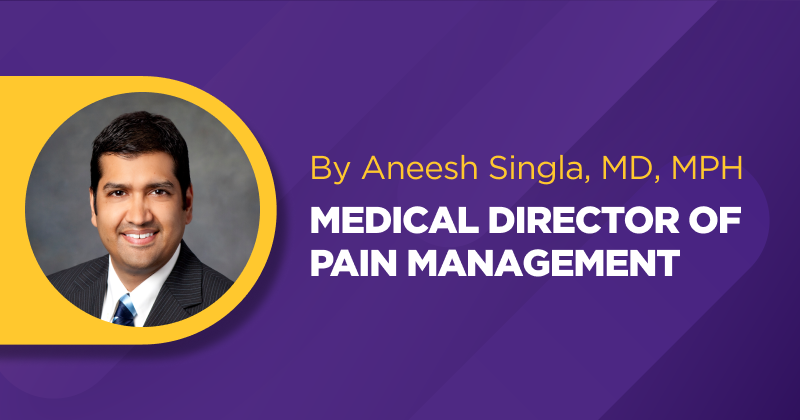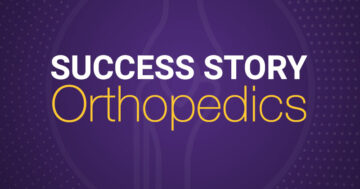The Making of a Pain Management EHR

This pain management physician helped build a pain management EHR he can trust to get the job done
An interventional pain specialist since 2005, Dr. Aneesh Singla is the Medical Director of Pain Management for ModMed®. He’s experienced in minimally invasive treatments for chronic pain. Dr. Singla came to ModMed in 2015 because he couldn’t find an EMR that fit his needs, so he decided to help build one. Here, in his own words, Dr. Singla reveals his experiences building ModMed Pain Management.
A pain management-specific EHR built by and for pain management physicians
It was a herculean process to compile and build all of the pain management content that I felt was needed in the software. I wanted the software’s capabilities to match how it actually works in my pain management clinic as a practicing physician. After approximately six months, we rolled out the software to our practices in Maryland.
I’m proud of this software because it isn’t written by a single programmer sequestered in a remote location with zero clinical experience. I developed this software with the help of other physicians in conjunction with our programmers to closely mirror day-to-day clinical workflows, and we meet periodically to make updates that reflect real changes in the pain management world.
An intuitive, pain management physician-friendly interface
One of the most important aspects of our software that I’ve emphasized to our programmers since becoming Medical Director of Pain Management at ModMed is that it must be intuitive. Everything needs to flow.
Within the EHR system, both acute and chronic pain diagnoses have pain management treatment content attached to them. And this is true for almost every pain management diagnosis, including sciatica, lumbar spinal stenosis, and radiculopathy. The software is in tune with the pain management specialty.
Personally, I prefer to use the iPad to see pertinent patient information in a dashboard that gives me what I need at a glance. The system provides important information I need at the point of care.
The system displays my most frequently used diagnoses and learns how to adjust these over time. I don’t have to go and search for them. After I select a diagnosis, my preferred treatment plans pop up right away. I can see the patient’s current status, my plan of action, and next steps in a concise note.
Continuously working with the team to reduce clicks
When you have intuitive software, it almost naturally follows that you will click less and less over time. I think this is a continuous growth opportunity for ModMed and the EHR industry as a whole. How do we reduce repetitive clicking and “click fatigue” so we can focus on the clinical care of the patient? A lot of EHR companies emphasize the bells and whistles, but we need to look at what empowers our physicians to provide quality patient care in pain management.
Right now, we’re trying to cut our documentation time down to two minutes per visit — that’s our ultimate goal. Protocols can help us get there. Protocols are plans of action that encompass treatments, orders, patient education and more for a given diagnosis and generate a treatment plan. When I see a lumbar stenosis patient, I generally tend to follow a similar plan of action with slight modifications. My protocol applies my plan in a single tap on the iPad, saving me multiple clicks. Then I can edit each component of the plan to customize it to my patient’s individual needs, while simultaneously saving time.
Staying ahead of regulatory changes in pain management medicine
Over the last several months, Medicare’s Local Coverage Determinations have focused on appropriate use of interventional pain management procedures. For example, there are new criteria that a pain management specialist must follow in order to get appropriate reimbursement for administering epidural steroid injections. We’ve built a simple checklist into our EHR so physicians can clearly see if Medicare’s criteria are being met.
For example, if you want to refer a patient for an epidural, you can see if a patient meets the criteria or not. If the patient needs to wait two weeks, or if they need to try a different treatment prior to their next injection, it’s clearly delineated in the chart. Physicians and billing staff can feel more confident that they’re meeting the LCD requirements in case of an audit.
Evolving the software to match the specialty
In medicine, there’s an evolutionary process within every medical specialty. New technology, better techniques and better procedures for pain management are constantly being invented and refined, and frequently, the government’s reaction to these innovations affects the way we have to back up our documentation. I meet with our programmers regularly to share the changes I’m seeing in my practice to help evolve the software to better meet my needs, and, hopefully, the needs of the majority of pain management physicians.
About Dr. Aneesh Singla
Dr. Aneesh Singla is the Medical Director of Pain Management for ModMed. He is experienced in the most advanced minimally invasive treatments for chronic pain, including spinal cord stimulation, kyphoplasty, radiofrequency lesioning and various other treatments for low back pain.
Dr. Singla attended medical school at the University of North Carolina at Chapel Hill, where he graduated with honors, and also obtained a master’s in public health, focusing on health policy and administration. During his residency in Anesthesiology at Massachusetts General Hospital, Dr. Singla also completed a fellowship at the Partners Institute for Health Policy, where he conducted research in patient safety and other health policy research. Dr. Singla served as the chair of the Massachusetts Medical Society Resident and Fellow Section, and was a member of the Board of Directors (Committee on Publications) for the New England Journal of Medicine.
After his residency, Dr. Singla completed an interventional pain fellowship at Brigham and Women’s Hospital, both affiliated with Harvard Medical School. He served on the physician faculty with the title of Lecturer at Harvard Medical School through 2019, and is currently practicing at National Spine & Pain Centers in Maryland.
This blog is intended for informational purposes only and does not constitute legal or medical advice. Please consult with your legal counsel and other qualified advisors to ensure compliance with applicable laws, regulations, and standards.







